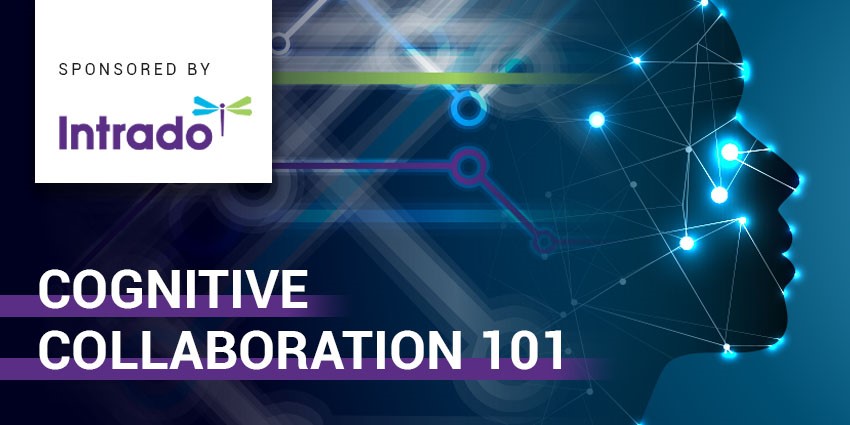Collaboration is a term that we constantly see in the business space these days.
Companies have realised that if they want to get ahead of the competition, they need more than just the right communication. They also need a way for their team members to connect efficiently and effectively too. Cognitive collaboration is a concept introduced by leading communication company Cisco, to support the changing nature of the modern workplace.
Cognitive collaboration is a concept that combines the creativity and empathy of the human workforce, with the accuracy and speed of artificial intelligence and machine learning. You get the best of both worlds in one environment. With cognitive collaboration, businesses can augment agent experiences by giving them access to the information and tools they need to transform customer experiences and drive more productive moments.
So, how do you start implementing cognitive collaboration into your workplace?
1. Plan Your Strategy
The benefits of cognitive collaboration are clear. Businesses that bring intelligence into their communication experience can reap the advantages of a more informed team. Tools like People Insights can drive more meaningful conversations between people who understand the talents and skills of the colleagues that they’re interacting with. Intelligent meeting rooms with virtual assistants and bots allow work to be completed faster in a time when productivity and efficiency are crucial.
However, just because your company can see the value of cognitive collaboration, doesn’t mean that you’ll be ready to rip and replace your entire ecosystem just to unlock these new advantages. Many businesses, particularly larger enterprises have existing investments in technology that they’re not ready to give up yet. This means that it’s important to think about how you’re going to build on top of your existing developments, rather than just replacing them.
Cisco partners like Intrado can help companies with existing investments to think about how they can create a Next-gen conferencing, collaboration and meeting room experience through hybrid deployments. Increasingly, the Cisco stack is proving it’s ability to integrate with other solutions from Poly, Microsoft, and other leading vendors. Working with Intrado, companies will be able to decide which of their existing investments they want to keep hold of as they move into the future.
2. Introduce the Benefits to your Team
Embracing cognitive collaboration also means exploring the potential of artificial intelligence and machine learning. For some businesses, this can be a worrisome concept. There are still employees out there that believe intelligent bots will one day take over their jobs. To increase adoption and improve the sentiment towards cognitive collaboration in your business, it’s essential to explain the benefits to your team.
Let your team members know that combining tools like artificial intelligence, advanced algorithms, and natural language processing will give them access to useful, contextual insights as they perform their tasks each day. This will help them to overcome the common friction points that might slow down their performance. Currently, 53% of businesses believe that intelligent meeting rooms will be vital to improving their business processes.
Remind your people that the digital assistants and AI that you bring into the workforce will be there to empower them, not replace them. Although it may take some time to transform your company culture, helping team members to embrace the benefits of AI will help your migration to move faster.
At the same time, it’s worth remembering that embracing a next-gen collaboration strategy doesn’t have to mean starting from scratch. It can be easier to drive adoption in a business when your team members understand that they won’t necessarily need to give up on things like Microsoft productivity tools, Poly endpoints, and Lifesize tools, just so that they can move into the next level of their relationship with Cisco.
3. Set Goals for Your Cognitive Collaboration
Once your team members understand the benefits of cognitive collaboration to them and your business, the next step is to establish some goals. Whenever you’re rolling out new technology for your company, it’s always helpful to have a vision of what you want to achieve with those new solutions. Considering what you want to accomplish will help you to track your progress more effectively over time.
For instance, cognitive collaboration is a great way to foster deeper relationships between your team members through things like people profiles. Your goal may be to improve the company culture in your workforce. In that case, you can measure staff turnover, employee satisfaction levels, and overall productivity. Another option may be to set a goal for greater efficiency in the workplace. Cognitive collaboration relies heavily on robotic process automation that can remove the repetitive tasks that your team members need to focus one each day.
If your people can spend less time on monotonous jobs, they may also be able to get more done when it comes to complex situations each week. Measure how quickly your employees reach deadlines and personal targets when cognitive collaboration is introduced.
Partners like Intrado can help companies to expand their UC strategy with a focus on achieving specific goals. Intrado believes that the best way to get started in the world of cognitive collaboration is to find out what each user needs and then work backwards from there, looking for the intelligent tools and systems that will solve the company’s most pressing problems. If you don’t know what you want to accomplish with intelligent collaboration yet, then you may need to expand your education before you invest in any new technology.
4. Explore New Technology and Offer Training
Implementing cognitive collaboration into your business may also mean adopting new technology. Companies like Cisco are investing heavily in the disruptive new tools that can make cognitive collaboration more effective, such as digital assistants, in-meeting profiles, and facial recognition. If you’re going to bring some of those functionalities into your workplace, then some additional training may be necessary for your team.
Consider the features that you’re going to be using as part of your cognitive collaboration journey. For instance, if you’re interested in the “People Insights” tool from Cisco, then you’ll need to show your employees how to use this capability to access rich profiles about the people that they’re meeting with before a conversation begins.
You might also want to run some basic training sessions on things like proactive join for your meeting rooms, and first match, a system that uses conversational AI to help your employees connect with the people that they want to reach as quickly as possible. Cognitive collaboration offers opportunities for more intelligent interactions between your team members – but only if they know how to use it to their advantage.
It’s worth noting that your journey into the cognitive collaboration landscape may change depending on the structure of your workplace. Businesses that operate entirely “on premises” will have a harder time unlocking the full benefits of artificial intelligence in the collaborative environment. That’s because AI and machine learning tools need to be constantly fed with useful and up-to-date data. Information held behind an on-premise firewall can’t feed an AI strategy, meaning that companies will need to think carefully about whether it’s time to embrace the cloud as they move forward.
5. Choose the Right Partners
The most essential part of any digital transformation strategy is choosing the right partners. For instance, in the cognitive collaboration world, Cisco is currently the brand that’s leading the way for more intelligent meeting room environments. Over the last year, Cisco has begun to rapidly innovate in the collaborative environment, introducing everything from facial recognition software to audio transcription, to bring the concept of cognitive collaboration to life.
Of course, there’s more to building your cognitive collaboration success team than finding the right vendor. You may also need the assistance of a professional partner like Intrado (West) to help with implementing that new technology and making the most of it too. A dedicated partner like Intrado can guide you through the process of implementing new technology into your collaborative roadmap so that you can see the full benefits of this ideology for yourself.
Professional partners can also offer fantastic added service offerings that ensure you’re experiencing the right outcomes for your investment, according to your specific use case. Intrado doesn’t just deliver Cisco technology and conferencing. The company focuses on delivering the results that today’s individual businesses need as they explore the potential of the new intelligent collaboration space. With a partner like this, companies can rest assured that they’re investing in a next-gen stack that’s built according to their challenges and goals.
Make the Most of Cognitive Collaboration
Cognitive collaboration has the power to transform the meeting space forever, particularly in a time when employees are becoming more mobile, remote, and diverse than ever before. With cognitive collaboration, businesses of all sizes can discover the benefits that come with keeping their teams connected and engaged, no matter the situation.
Vendors like Cisco are introducing the world to a new model of collaboration. This advanced new strategy brings together the benefits of the human world, and the artificial intelligence environment, to deliver something stronger than each segment.
Are you ready to discover cognitive collaboration?







